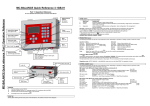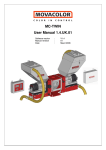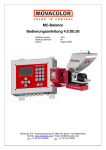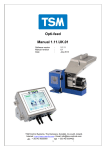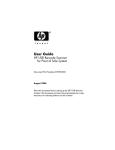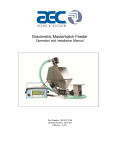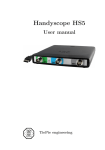Download MC18-Micro User manual 1.08.UK.00 - Dryers-Loaders
Transcript
MC18-Micro User manual 1.08.UK.00 Software Version Manual Revision Datum : : : V1.08 µ1.00 00 June 2011 Movacolor B.V • Koperslagersstraat 31• 8601 WL Sneek • The Netherlands Internet: www.movacolor.com • Email: [email protected] + 31 (0) 515 570020 + 31 (0) 515 570021 INDEX INDEX _____________________________________________________________________________________________________ 3 1. Introduction ______________________________________________________________________________________________ 2 2. General information ________________________________________________________________________________________ 3 2.1 Safety ________________________________________________________________________________________________ 3 2.2 Certification ____________________________________________________________________________________________ 3 2.3 Operating environmental conditions _________________________________________________________________________ 3 3. Capacities ________________________________________________________________________________________________ 4 4. Installation _______________________________________________________________________________________________ 5 4.1 Transport ______________________________________________________________________________________________ 5 4.2 Receipt _______________________________________________________________________________________________ 5 5. Installation hopper loader (optional) __________________________________________________________________________ 7 5.1 Mechanical installation ___________________________________________________________________________________ 7 5.2 Compressed air installation ________________________________________________________________________________ 7 5.3 Connecting material line __________________________________________________________________________________ 7 5.4 Adjusting compressed air flow______________________________________________________________________________ 8 5.5 Sensor adjustments ______________________________________________________________________________________ 8 6. Operation ________________________________________________________________________________________________ 9 6.1 The Interface ___________________________________________________________________________________________ 9 6.2 General _______________________________________________________________________________________________ 9 6.3 Start up ______________________________________________________________________________________________ 10 6.4 Configuration __________________________________________________________________________________________ 10 6.5 Speed 6.6 and timer Tacho function _____________________________________________________________________________________ 11 6.7 Production (Motor On/Off) 6.8 Test 6.9 ________________________________________________________________________________ 10 ________________________________________________________________________ 11 (material output) ________________________________________________________________________________ 12 Automatic hopper loaders (optional) ____________________________________________________________________ 13 6.10 Keyboard lock _______________________________________________________________________________________ 14 7. Alarms __________________________________________________________________________________________________ 15 7.1 General ______________________________________________________________________________________________ 15 7.2 Filling alarm [FILA] (optional) _____________________________________________________________________________ 15 7.3 Motor connection failure [Err0] ____________________________________________________________________________ 15 8. System performance ______________________________________________________________________________________ 16 9. Maintenance (hopper loaders) ______________________________________________________________________________ 17 9.1 Preventative maintenance schedule ________________________________________________________________________ 17 10. Troubleshooting hopper loaders ___________________________________________________________________________ 18 10.1 Conveying problems and solutions. _______________________________________________________________________ 18 APPENDIX A: MC-18 Wiring Diagram _______________________________________________________________________ 19 APPENDIX B: MC18-Micro Technical Specifications __________________________________________________________ 20 APPENDIX C: MC18-Micro Technical Specifications Hopper loaders_____________________________________________ 21 APPENDIX D: MC18-Micro Drawing General Dimensions ______________________________________________________ 22 APPENDIX E: MC18-Micro Declaration of Conformity _________________________________________________________ 23 1. Introduction Thank you for purchasing a Movacolor metering device. This manual is addressed to operators and qualified technicians taking care of the metering of dry additives to ensure correct use of the Movacolor dosing unit. IMPORTANT NOTE: THIS MANUAL MUST BE READ BEFORE INSTALLING THE DOSING UNIT. KEEP THIS MANUAL IN A PLACE ACCESSIBLE FOR ALL OPERATORS. 1.1 Symbols Important note Attention; safety regulations for the operator 1.2 Terms Operator: A person charged to operate, adjust, maintain and clean the machine. Qualified Technician: A specialized, suitable trained person authorized to execute the installation, non-routine maintenance, or repairs requiring special knowledge of the machine and how it operates. -2- 2. General information 2.1 Safety The equipment is only designed and may only be used for the dosing of dry additives. Any use that does not conform to the instructions is considered improper and as such releases the manufacturer from any liability in regard to damage to things and/or persons. Before switching on the unit for the first time, ensure that the mains power voltage applied is between 80 and 260Vac. Always switch off the Movacolor control cabinet and disconnect the mains power plug from electrical power before performing maintenance. Ensure that all parts are securely fixed to the extruder or injection molding machine. Dangerous voltages are present inside the control cabinet for up to 2 minutes after it has been switched off. 2.2 Certification The Movacolor dosing unit is designed and produced in conformity with the following European regulations: • standards for machinery (health, safety, environment) • EMC (electromagnetic compatibility) • VEM (safety electric material) • 98/37/EC, Annex 1(See the declaration of conformity, Appendix E) 2.3 Operating environmental conditions • • • The unit must be protected against weather conditions Operating temperature -20 to +70 degr. C. Protection class: IP-50 -3- 3. Capacities Capacity graph 1 0,9 0,8 0,7 Capacity Gram/Second 0,6 0,5 0,4 0,3 0,2 0,1 0 0 20 40 60 80 100 120 140 160 180 200 Motorspeed [RPM] Note * Note ** Note *** measured with normal granular masterbatch 0,8 kg/dm3. measured with free flowing powder 0,65 kg/dm3. only available with high torque (4,5 Amp) stepper motor The actual capacity of the dosing system depends on: The volume weight of the material (bulk density) The specific weight of the material (specific density) The granular shape of the material The granule size The surface structure of the material Granular material can be normal or micro. The granular material and powder material has to be free flowing, non-static and not sticky. To determine the kind of material in your application use the description below. Material types Normal Granules: (NG) ø L Ø< Micro / Mini Granules: (MG) 4 mm L < 4 mm * ø L The term Micro/Mini Granules also includes free flowing powder. Ø < ø2,5 mm L < 3 mm * -4- 4. Installation 4.1 Transport To protect the Movacolor unit against damage during transport, the unit is packed in a cardboard box filled with polyurethane foam. Delivery terms are Ex-Works Sneek, The Netherlands. Buyer is responsible for the transport. Movacolor cannot be hold liable for any damage during transport. 4.2 Receipt Check the unit thoroughly upon receipt. Pass any remarks to the local agent or Movacolor within 8 days upon receipt of goods. 4.3 Electrical installation. The MC-18 controller is standard equipped with 3 connections: 1. 2. 3. Mains power cable, Before switching on the unit for the first time, ensure the mains power voltage being applied is between 80 and 260Vac. Input cable Motor cable Optional are: 4. 5. 6. Sensor, complete with cable Alarm flash light, complete with cable Compressed air solenoid valve complete with cable (for automatic hopper loader) Mains power switch On/Off 6.) Output 24VDC (hopper loader) See appendix A for wiring diagram 5.) External Alarm output 24VDC 4.) Sensor input 24VDC 3.) Motor cable 2.) Input (see installation) 1.) Mains power cable Input (start) signal The MC-18 needs an input signal from the production machine in order to operate. Three different input signals can be used to control the MC-18. 1.) A potential free relay contact. Use the white and brown wire for the potential free contact. 2.) A relay signal up to 24 Volt DC*. In case of a powered relay signal connect the white wire to +24 VDC and the yellow wire to - side. * Note potential contact Guaranteed OFF: 0-8VDC Guaranteed ON: 18-30VDC 3.) A tacho signal up to 30 Volt DC. -5- This is used when the MC-18 needs to be connected to an extruder that has a generator that produces a voltage linear to the extruder speed. When using a Tacho generator signal, connect the white and brown wire, connect green to + VDC and yellow to - side of the generator. See Paragraph 6.6 for information about the configuration of the tacho parameters. The maximum voltage that can be applied to the MC-18 is 30 VDC. The tacho voltage has to be reduced to 30 VDC if the tacho generator has a higher voltage output than 30 VDC at the maximum extruder output capacity. See the diagram below. Input connection Green wire + Resistor (Rx) kOhm 17 8 Yellow wire - Rx (kilo-Ohm) = (2,684 x (Max. tacho output VDC – 5)) – 66 -6- Tacho generator EXTRUDER 5. Installation hopper loader (optional) 5.1 Mechanical installation The Hopper loader lid fits directly on the hopper of the dosing unit. To fix the ME hopper lid the quick release clamps on the dosing hopper are used. 5.2 Compressed air installation The ME-loader uses compressed air to move material. The inlet for your compressed air supply line is on the solenoid valve. The air connection diagram can be found on the valve’s body. 1. Connect the compressed air to the ø8x6 compressed air connection on the solenoid valve The compressed air source must deliver a maximum of 4-8 bar of clean, dry (non-lubricated), air pressure. 2 . Make connections from the solenoid and the ejector pipe with the provided compressed air tubing. Quick disconnect fittings are provided for these connections. The tubing should be cut to length for maximum efficiency of the system. Use straight cuts to assure a good square tubing end. Confirm a good connection. CAUTION: Be sure to provide hazard-free routing of the tubing, to keep it away from hot or moving surfaces and out of the way of personnel. 5.3 Connecting material line The flexible hose need to be attached over the inlet pipe of the ME-hopper lid and ejector pipe. Secure the hose with a hose clamp. Reduce flex hose down to the shortest possible length, to avoid wasting compressed air energy. IMPORTANT: The material line should be as straight as possible. Avoid loops and S-curves in flexible hose This can hurt conveying performance. -7- 5.4 Adjusting compressed air flow Adjusting compressed air flow It is advised to use a flow regulator for the compressed air (not included). The air flow will determine how much material will be transferred and how fast the dosing unit will be replenished with material, with each loading sequence. The best is to adjust the air setting to its lowest possible level in order to conserve compressed air energy. Parameters such as distance, material line bends, the flow characteristics of the material and vertical rises in the flex hose all play a part in finding the proper setting. Ultimately, trial and error settings over several loading sequences will work best to determine the right air level. Too low of a setting may not move material effectively enough to satisfy demands cycle after cycle. Too much air will waste energy and cause the filter on the lid to prematurely blind in an attempt to evacuate excess air. 5.5 Sensor adjustments Sensor Depending on the material you may need to adjust the sensitivity of the sensor which is delivered with the hopper loader. At the back of the sensor is a small screw that can be used to adjust its sensitivity. To adjust, fill the hopper with material until the sensor is just covered and turn the screw until the light on the sensor goes on. Because the sensor is in direct contact with the material, it is recommended that the sensor will be initially adjusted for sensitivity and then re-adjusted, once the sensor becomes coated with typical material fines, common to plastics conveying. Capacitive Sensor Adjustment -The LED is ON when material is detected by the sensor. -The LED is OFF when no material is detected by the sensor. Sensitivity adjustment LED More sensitive Less sensitive -8- 6. Operation 6.1 The Interface Input LED Input LED is lighted when input signal is made. Increase / Decrease value Alarm LED Set dosing speed [RPM] Enter value Run test Set dosing time [sec.] Set hopper loader Set Tacho voltage [VDC] - Start LED blinking: Motor Standby / waiting on start signal. Start unit Stop unit - Start LED lighted continuously: Motor is running. 6.2 General • Connect motor before switching on the controller • • All changes have to be entered to acknowledge. A blinking value means the changed data is not entered. • • To cancel a changed value, press the specific function button ( or ) again. Most functions have a designated key and a LED on the interface. When a function is activated the LED of that key/function will light up. All functions except the test function can be activated when the unit is started. (depending on the chosen configuration.) • • Only one of the following functions , , can be active at the same time. This means no other function can be activated before the active function is deactivated The unit can be set to different configurations, see paragraph 6.4 -9- 6.3 Start up The MC-18 software version is displayed shortly when the unit is switched on, followed by the selected motor type Lo=Low Torque and HI=High Torque motor. After that the configuration mode (CON) will be shown. Configuration 1 2 3 4 5 6 Type of Production Injection Molding Injection Molding Extrusion Extrusion Extrusion Extrusion Input signal Timer Timer Relay Tacho Relay Tacho Hopper loader none or ME (when connected) none or MV (when connected) none or ME (when connected) none or ME (when connected) none or MV (when connected) none or MV (when connected) When the MC-18 is set to configuration 3 to 6, the time function key When a deactivated key is pushed the unit will give a beeping signal. is deactivated. 6.4 Configuration For changing the unit configuration, and enter pressed while switching on the main power. keep speed The configuration number will be displayed, press to switch between the possible configurations and press to acknowledge. The software version will be displayed. Configuration data is normally entered once and it remains the same for subsequent operation. The data entered during configuration is saved in memory and remains in the memory even when the unit is shut off or unplugged. Timer Timer mode is used for injection molding with a relay input signal. When the relay contact is made, the unit will start dosing according the number of seconds that has been set with the time function. Relay A relay signal can be used when working in extruder mode. With the relay input the unit will start dosing when the relay contact is made and will stop when the relay contact is interrupted. 6.5 Speed and timer Speed and dosing time can be altered (time only in case of injection molding) Speed Timer = rotation of dosing system in RPM, (0,1 to 200 RPM) = time dosing system will rotate after start impulse, at input cable ( 0,1 to 999,9 sec) Activate by pressing acknowledge or , set the desired speed or time using - 10 - press enter to 6.6 Tacho function The tacho function is available in configuration 4 & 6. This function can be used with extrusion when it is necessary that the dosing rate is automatically adjusted to the extruder speed. In tacho mode an input voltage is coupled to a dosing speed setting. If the extruder speed changes, the tacho input voltage and speed of the dosing unit will change accordingly. A linear correlation between extruder speed (tacho input signal) and the needed dosing speed is assumed. See graph. Speed (RPM) Tacho graph (Example) Tacho input voltage (VDC) Press to make the tacho function active. The display will show a numerical value that represents the current voltage of the tacho input signal. When (P1 in the graph) is coupled to the set speed (P2 in the graph). is pressed the current voltage During production, the speed (P2) can be changed. The new speed is coupled to the previous stored voltage and the graph will change accordingly. During production, the voltage (P1) can be adjusted to the current tacho input voltage by pressing followed by . The new voltage is coupled to the previous stored speed and the graph will change accordingly. The maximum voltage that can be applied to the MC-18 is 30 VDC. See paragraph 6.4 for information about the correct electrical connections of the tacho signal and information about connecting a higher then 30 Volt DC input signal. 6.7 Production (Motor On/Off) Press to start production. The start LED will start blinking when the unit is waiting for an input signal. The unit is dosing if the start LED is lighted continuously. - 11 - 6.8 Test (material output) The test function is used to calibrate the MC-18 The test function can only be used when the motor is stopped . How it works Determine the dosing unit RPM entirely manual. This can be done by drawing up the dosing characteristic manually, or by recording the relation of the RPM versus the system output in a chart. With this multipoint chart, it is possible to determine the rpm that corresponds to the dose amount. This must be repeated for every dosing setting because the dosing conditions and the used materials are usually very different. Manual made dosing graph made at 3 sec dosing time 7 grams per shot 6 Output in gram 5 4 3 2 1 0 0 10 30 60 90 120 150 180 200 RPM Test procedure to determine output of dosing system: Place dosing unit horizontally leveled (water level surface). Set the speed (and or) time for Test Press Weigh the material dosed during test Adjust speed or time and repeat Test if necessary. Note: (Configuration 1 & 2 / Injection Molding): (Configuration 3 to 6 / Extrusion): Emergency stop. If the test is activated press stop The unit will dose at the set speed and time . The unit will dose for 30 seconds at the set speed to cancel a test. - 12 - 6.9 Automatic hopper loaders (optional) Hopper loader settings This part of the manual describes how to make the hopper loader settings. For further technical information about the hopper loader consult the specific hopper loader manual. General The hopper loader is only activated when the motor is On Emergency stop. To stop the hopper loader during production press press to acknowledge. . , select “Off” by pressing or and Input signal (sensor) Depending on the material you may need to adjust the sensitivity of the sensor which is delivered with the hopper loader. At the back of the sensor is a small screw that can be used to adjust its sensitivity. To adjust, fill the hopper with material and turn the screw until the light on the sensor goes on. Output signals During fill time [FILt] there will be a 24VDC signal between connection 20 and 21 on the main board to activate the pneumatic solenoid valve (See appendix A) The hopper loader LED on the front of the controller indicates the status of the valve output. When the Fill Alarm [FILA] is active there will be a 24VDC signal between connection 18 and 19 on the main board to activate the flash light. (See appendix A). The controller itself gives a beeping signal and the alarm LED will lighten up. ME settings Configuration 1, 3 and 4 (see paragraph 6.3 & 6.4) Press to change ME hopper loader settings, the display will show in following order: On / Off: Press to switch the ME-hopper loader On or Off and press acknowledge. FILt: Fill time [sec.], during this time the system blows material into the hopper of the dosing unit. Press to change the time and press to acknowledge. Recommended basic setting: 15 sec FILA: Fill Alarm [sec.], if sensor is NOT covered within this time, the alarm starts. Press to change the time and press to acknowledge. Recommended basic setting: 30 sec - 13 - to 6.10 Keyboard lock + + = Lock / Unlock, Display shows : L.ON / L.OFF - 14 - 7. Alarms 7.1 General To cancel an alarm press enter . When an alarm is active there will be a 24VDC signal between connection 18 and 19 on the main board to activate the flash light. (See appendix A). The controller itself gives a beeping signal and the alarm LED will lighten up. 7.2 Filling alarm [FILA] (optional) The MC-18 is able to give an alarm when there is not sufficient material inside the hopper. Alarm settings when using a automatic hopper loader. See paragraph 6.9 Alarm settings manual hopper filling (without automatic hopper loader) In case of manual filling of the hopper, the hopper loader control of the MC-18 is used to generate the filling alarm. A sensor and an alarm output is needed. Use the settings below. ME: ME hopper loader = ON FILt FILA = 0,1 = 0,2 The Filling alarm is self eliminating, this means that the alarm will stop automatically when the sensor is covered with material. If an alarm is canceled by pressing enter the next alarm will come (if the sensor is still not covered) with a delay of 60 seconds. This gives the operator the time to manual fill the hopper without having the alarm on. 7.3 Motor connection failure [Err0] Err0 : Motor connection failure. Make sure the motor is connected Check cable and connectors for damage. Press enter to stop the alarm. When the MC-Micro unit is supplied excluding dosing unit (only hopperloader, no dosing motor) [Err0] is disabled (Jumper 1 “JP1” on the Mainboard is placed in the “OFF” position.) This jumper is located on at the upper right side of the Mainboard. To activate the motor alarm [Err0], jumper 1 must be placed in the ON position. - 15 - 8. System performance The following variables may influence the accuracy and repeatability of the system: 1. Material properties. Easy flowing, non-sticky and non-static material that comes in the form of small regular shaped granules or powder can be dosed very accurate and regular. 2. Periodical cleaning of the dosing cylinder and seals is necessary for proper operation. 3. Extreme vibrations and shocks can have negative influence on system performance. 4. An unstable relay signal has a negative influence on the repeatability. 5. With injection molding the shot to shot accuracy depends, besides the variables mentioned so far, on the shot time in combination with granule size and weight. If relatively big and heavy granules have to be dosed in a very short time, it will influence the shot accuracy and repeatability, because if only a few granules are dosed during the shot, one granule more or less makes a big difference on the total shot weight. 6. Vacuum or overpressure in the neckpiece caused by driers or hopper loaders. 7. Bridging or rat holing of the material inside the hopper can happen if the material is not free flowing. 8. Bridging or rat holing of the material inside the hopper can happen if the material is extremely static. 9. Extremely static material can contaminate the dosing cylinder. 10. In case of water cooled neckpiece, check if there is material build up around the dosing cylinder and the water cooled pipe. Check also the water supply to the neckpiece. - 16 - 9. Maintenance (hopper loaders) 9.1 Preventative maintenance schedule • Daily Clean the conveying filter. If you are running a dusty material or regrind you may need to check and clean the filter more often. The filter should be cleaned whenever you change materials. - 17 - 10. Troubleshooting hopper loaders 10.1 Conveying problems and solutions. WARNING: Disconnect power and air sources. Always disconnect the loader from its main power source and compressed air course before servicing. This prevents the loader from starting during servicing, which could cause personal injury. Problem Possible cause Solution Low or no material flow. Does the filter need to be cleaned? Are there kinks in the flex hose? Check the filter, if it is clogged with dust or fines, clean the filter. Check the material flex hose line for loops and “S” curves. Remove any loops and “S” curves in the flex hose. Try to keep the hose as straight as possible. Check the material line for holes, cracks Check the material line hose connections for leaks especially at the ejector pipe connection. Hose clamps should be used. Check the compressed air adjustment to make sure it is properly adjusted for optimum flow. Too much air will prematurely blind the filter; too little air will create clogs. Replace/refill the material container Are hose connections too loose? Are compressed air adjustments correct? Do you have enough material at the source? Has material plugged the flexible hose? Is the compressed air tubing connected? Loader will not cycle. Are all electrical connections correct? Filter clogs frequently. Is there too much compressed air flow? - 18 - Check the material flex hose line for loops and “S” curves. Remove any loops and “S” curves in the flex hose. Try to keep the hose as straight as possible. Assure that the ejector pipe (s) are supplied with compressed air via the supplied tubing. Check to make the sensor is connected to the control and the solenoid is connected to the control. Adjust the air flow to minimum possible level to prevent excessive dusting and filter clogging. APPENDIX A: MC-18 Wiring Diagram Input (start) signal 9 10 + IN 10 8 8 9 10 - 17 8 = Yellow Jumper settings 9 = Brown To switch from stepper motor 2A to stepper motor 4,5A 10 = White + ON Stepper motor 4,5A 17 = Green - + Stepper motor 2 A OFF Potential free contact JP2 Tacho Potential contact [Min 18VDC to Max.24VDC] [Min 0VDC to Max. 30VDC] Sensor input (24VDC) INP2 12 = Blue = Brown 13 = White 7 6 5 4 Alarm (+) Valve (-) Valve (+) Coil 1 Alarm (-) 11 White (4) Capacity sensor Green (3) 13 Yellow (2) 12 +24VDC Inp.2 Brown (1) 11 Gnd Motor 18 19 20 21 Output 1 Internal wires main power switch X5 Blue (N) X4 Brown (L) Output 2 Outputs [ 24 VDC] = White 21 = Brown To open the control cabinet use the 4 bolds on the top and bottom side, not the 6 bolds at the front side. WARNING Do not make any changes to the main board/components ore warranty will lapse. Power Supply Western Europe PE N L 3 2 1 Brown = Brown 20 Blue = White 19 Green/Yellow 18 Coil 2 - 19 - USA,Canada,Mexico, Mid America,Japan,Taiwan 1 = Black 2 = White 3 = Green X3 Black (N) X2 Black (L) APPENDIX B: MC18-Micro Technical Specifications Controls: Speed: Time: Manual setting from 0,1 to 200 RPM max, in increments of 0,1 RPM. Manual settings from 0,1 to 999,9 sec in increments of 0,1 sec. Voltage settings of tacho-voltage: auto-detect Integrated hopper loader controller Monitoring/System Information/External communication 4-piece 7 segments LED at front display. Man/Machine interface: keypad External Communication: none Alarm: LED Indication + Internal beeper, 1x external alarm output. Specifications/Standards & Directives/ Technical data: Power supply: Operating power from 80 VAC to 260 VAC, 50 and 60 Hz by integrated automatic voltage selector Power consumption: 80 Watt maximum Stepper motor: (1,8degr/step) max 2 Amp at 40 Volt. Operating Temperature: -20 to +70 degr. C. Input signal(s): Injection molding: Extrusion: Start/Stop trigger input, potential free or 18-24VDC* Input for level sensor. Start/Stop trigger input, potential free or 18-24VDC* Tacho input 0..30VDC Input for level sensor. * Note potential contact Guaranteed OFF: 0-8VDC Guaranteed ON: 18-30VDC Output(s): -Stepper motor max. output 2A (40VDC) -Solid state 24VDC/0.5 A output for valve hopper loader -Solid state 24VDC/0.5 A output for external alarm -Maximum total output power: 12 Watt (Valve output + alarm output) Standard Directives: Protection class: IP-50 According to CE standards: EN50081-2 (HF radiation industry) EN50082-2 (HF immunity industry) Safety • • In case of overload due to short-circuit or in correct connection, the power supply automatically shuts down. Opto insulated start input for connection to production machine. Optional parts • External Alarm Flash light. • External Alarm Siren. - 20 - APPENDIX C: MC18-Micro Technical Specifications Hopper loaders Loader model Maximum capacity* with 1,8 ltr hopper Maximum Capacity* (value mentioned only for reference) Standard conveying distance Material hose Compressed air hose Compressed air requirements Consumption Filter type Additional Filter Cloth for fine dust. ME25 (For normal granules and small regrind) 15 kg/h ( based on 10 seconds ON time and 3 minutes OFF time) 175 kg/h (at continuous working) 3 mtr Ø25mm (inside diameter) PVC hose with antistatic wire. Maximum temperature 60°C Ø6x1mm, outside ø8mm 4 to 8bar 0,25 to 0,45 m3/min. Stainless steel Perforated plate, hole size ø2mm. Filter cloth 120x120x12mm, EN779 classification G4 * The capacities are measured with normal granules with a bulk density of ~0,8 kg/dm3. Granule size 3-4 mm. De mentioned capacities are orientation values because capacity depends on material properties. - 21 - APPENDIX D: MC18-Micro Drawing General Dimensions - 22 - APPENDIX E: MC18-Micro Declaration of Conformity DECLARATION OF CONFORMITY (According to 98/37/EC, Annex 1) Manufacturer’s name : MOVACOLOR BV Address : P.O. Box 3016 8600 DA Sneek The Netherlands Declare under our sole responsibility that the product: Name : Movacolor Model : MC-18-Micro Year : 20….. Serial nr. : ………………. - Complies with the definition of the Machine Directive (98/37/EC), and complies with the national legislation to enforcement of this directive; - complies with the requirements of: Low Voltage Directive EMC Directive - (73/23/EEC) (89/336/EEC) complies with the following standards or other normative documents: NEN-EN 292-1/2 Safety of machinery part 1 + 2 (Signature) Place: Sneek the Netherlands Managing Director Date: June 16, 2011 - 23 - - 24 -




























